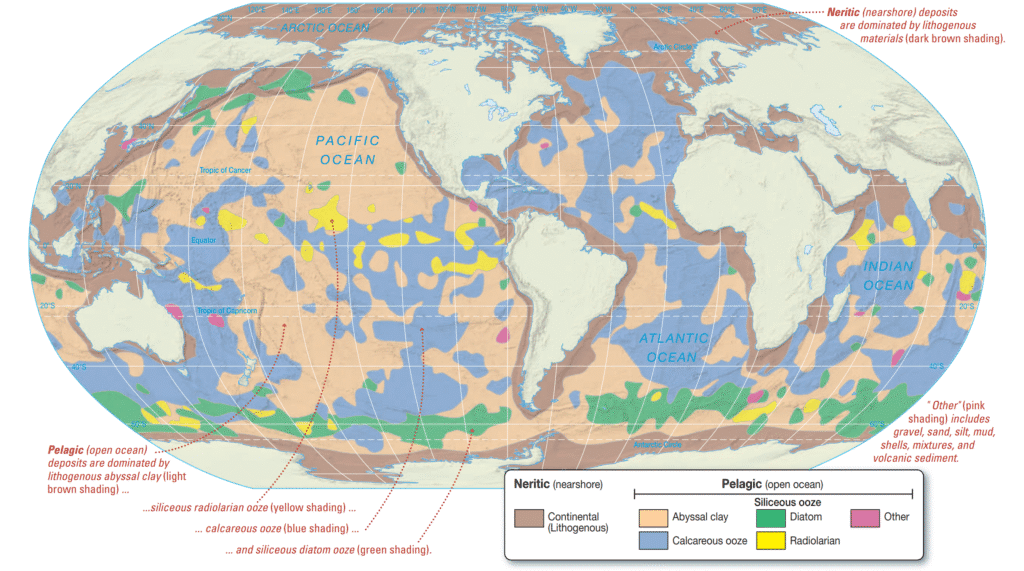How are Pelagic and Neritic Deposits Distributed in the Ocean?
Pelagic and neritic deposits are distributed based on water depth and proximity to land. Neritic deposits occur in shallow waters up to 200 meters on continental shelves, covering 25% of the seafloor with coarse-grained terrigenous materials from land erosion. Pelagic deposits dominate deep ocean basins beyond 200 meters depth, covering 75% of the seafloor with fine-grained biogenous oozes from marine organisms. The distribution is controlled by proximity to lithogenous sediment sources, biological productivity, and oceanographic processes.
Marine sediments are categorized into different types based on their origin and composition. According to oceanographic research on marine sediment classification, these deposits can be broadly divided into terrigenous, biogenous, hydrogenous, and cosmogenous materials.
The marine environment is inherently complex and dynamic. Lithogenous and biogenous sediments are seldom found as entirely pure forms devoid of any other sediment categories. Consequently, most oceanic deposits consist of diverse compositional mixtures.
Mixtures of Marine Sediment
A wide array of marine sediment combinations exists. Consider the following illustrative instances:
- A majority of calcareous oozes incorporate a minor proportion of siliceous material, and the inverse is also true.
- The widespread distribution of clay-sized lithogenous particles globally, combined with their mobility through wind and oceanic currents, results in their presence across virtually all sediment classifications.
- The makeup of biogenous ooze frequently includes as much as 70% of fine lithogenous clay particles.
- Most lithogenous deposits feature trace quantities of biogenous materials.
- A broad spectrum of hydrogenous sediments also contributes to the mixture.
- Microscopic traces of cosmogenous sediment are dispersed among all sediment varieties.

Sediment accumulations on the oceanic seafloor are generally characterized by a combinatory composition of multiple sediment types. The sediment distribution across a passive continental margin exemplifies how these mixtures manifest. Despite this inherent complexity, a single sediment type typically exhibits predominance, enabling the classification of the deposit as primarily lithogenous, biogenous, hydrogenous, or cosmogenous.
What Are Neritic Deposits?
Neritic—or nearshore—deposits occupy approximately one-fourth of the oceanic floor, while pelagic deposits, found in the deep-ocean basins, encompass the remaining three-fourths. The global spread of both neritic and pelagic sediment types across the oceans reveals that coarse-grained lithogenous materials are the dominant component along continental margins (depicted in dark brown shading). This predominance is expected given that lithogenous sediments originate primarily from adjacent continental sources. Although neritic sediment layers may also include biogenous, hydrogenous, and cosmogenous particles, these constitute only a minor portion of the overall sediment composition.

What Are Pelagic Deposits?
The distribution of pelagic sediment highlights a significant dominance of biogenous calcareous oozes (represented by blue shading), primarily found in relatively shallow regions of the deep-ocean floor, especially along the mid-ocean ridges. Biogenous siliceous oozes tend to accumulate beneath zones of exceptionally high biological productivity, such as in the northernmost parts of the North Pacific Ocean, the areas surrounding Antarctica (shown in green shading, where diatomaceous ooze is present), and the equatorial Pacific region (highlighted in yellow shading, where radiolarian ooze occurs). Fine-grained lithogenous sediments, referred to as abyssal clays (light brown shading), are prevalent in the deepest sections of the ocean basins, particularly within the North Pacific. In contrast, hydrogenous and cosmogenous materials contribute only a negligible fraction to the total mass of pelagic deposits.
Key Facts
| Aspect | Neritic Deposits | Pelagic Deposits |
|---|---|---|
| Location | Continental shelves, <200m depth | Deep ocean basins, >200m depth |
| Coverage | 25% of seafloor | 75% of seafloor |
| Grain Size | Coarser (sand, silt, gravel) | Finer (clay, ooze) |
| Source | Land erosion (terrigenous) | Marine organisms (biogenous) |
| Deposition Rate | Higher (rapid) | Lower (slow) |
| Examples | Gulf of Mexico, North Sea | Atlantic abyssal plains, Pacific red clay |
How Sea Floor Sediments Represent Surface Conditions
Given their microscopic dimensions and the vast distance separating the ocean surface from the abyssal plains, biogenous tests—the hard remains of marine microorganisms—would typically require 10 to 50 years to descend from the upper ocean layers, where the organisms once thrived, to the deep-sea floor, where biogenous ooze accumulates. In that extended duration, even a slow-moving horizontal ocean current, traveling at merely 0.05 kilometers (0.03 miles) per hour, could displace these tests as far as 22,000 kilometers (13,700 miles) before they ultimately settle on the deep-ocean bed.
This raises a compelling question: Why do biogenous remains on the sea floor so accurately mirror the biological populations inhabiting the overlying surface waters? The answer lies in a remarkable natural process. Approximately 99% of the particulate matter that reaches the seafloor does so within fecal pellets. These are produced by tiny marine animals that consume algae and protozoans within the water column, digest their soft tissues, and excrete the indigestible skeletal remains.
These fecal pellets, densely packed with remnants of surface-dwelling algae and protozoans, are compact enough to descend to the ocean floor in just 10 to 15 days, despite their small size. Upon reaching the seafloor, the organic components of the pellets are swiftly decomposed by bacteria and microbial communities, leaving behind only the inorganic, resistant hard parts, which are then incorporated into the marine sediment.
Reference: All images and content are taken from Essentials of Oceanography by Alan P. Trujillo and Harold V. Thurman, 12th Edition.
